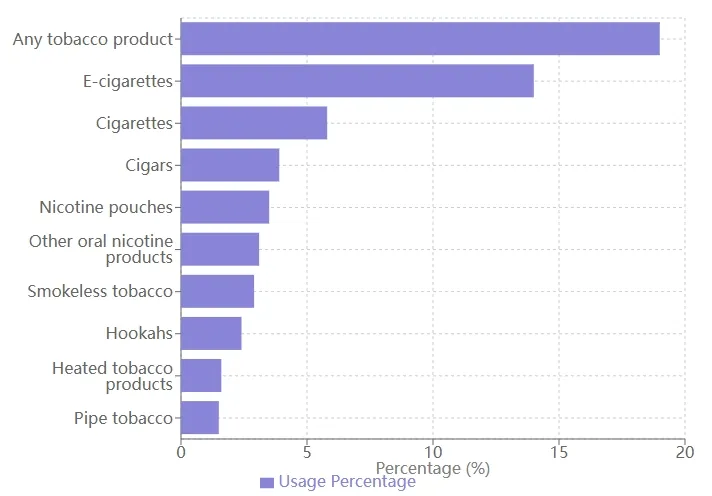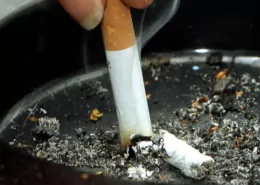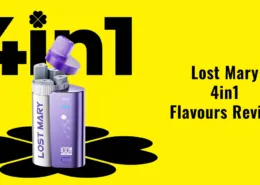U.S. Youth Tobacco Use Reaches 25-Year Low
E-Cigarettes Remain Most Commonly Used Tobacco Product Among Youth for 11th Consecutive Year
The Centers for Disease Control and Prevention (CDC) and the U.S. Food and Drug Administration (FDA) have released new data from the 2024 National Youth Tobacco Survey (NYTS), revealing that current tobacco product use among U.S. middle and high school students has dropped to the lowest recorded level in 25 years. Within the past year, at least half a million fewer students are using tobacco products, contributing to this significant progress.
In 2024, 2.25 million middle and high school students reported current use of any tobacco product, compared to 2.80 million in 2023. This decline was largely attributable to the significant drop in the number of students who reported current e-cigarette use, with 2.13 million youth in 2023 compared to 1.63 million youth in 2024. Current hookah use also experienced a significant decline, from 290,000 in 2023 to 190,000 in 2024. Cigarette smoking reached the lowest level ever recorded by the survey, with only 1.4% of students reporting current use in 2024.
E-Cigarettes Remain Most Commonly Used Tobacco Product, Nicotine Pouches Second
Despite the overall decline in youth tobacco use, e-cigarettes remained the most commonly used tobacco product for the 11th year in a row, with 5.9% of youth reporting current use. In 2024, nicotine pouches became the second most commonly used tobacco product among youth at 1.8%, followed by cigarettes (1.4%), cigars (1.2%), smokeless tobacco (1.2%), other oral nicotine products (1.2%), heated tobacco products (0.8%), hookahs (0.7%), and pipe tobacco (0.5%).

Varying Progress Across Population Groups
The report found varying progress across population groups. During 2023-2024, current use of any tobacco product, e-cigarettes, and multiple tobacco products significantly declined among female students, and current use of any tobacco product, e-cigarettes, cigars, hookahs, and multiple tobacco products declined among Hispanic students.
In contrast, during the same period, current use of any tobacco product, e-cigarettes, oral nicotine products, any combustible tobacco product, and multiple tobacco products all increased among American Indian or Alaska Native students, and current use of nicotine pouches increased among White students. No significant changes occurred in current use of cigarettes, smokeless tobacco, heated tobacco products, and pipe tobacco for all assessed race and ethnicity groups.
Evidence-Based Strategies and Continued Vigilance Needed
The observed decline in tobacco product use is likely the result of multiple factors, including the implementation of evidence-based strategies at the national, state, and local levels. These strategies include price increases, mass media campaigns to educate youth about the harmful effects of all tobacco products, and comprehensive smoke-free policies that include e-cigarettes. The FDA also continues to regulate the tobacco product marketplace by conducting thorough premarket review and using the full scope of its compliance and enforcement tools across the supply chain.
Deirdre Lawrence Kittner, Ph.D., M.P.H., director of CDC’s Office on Smoking and Health, emphasized the need for continued commitment to public health efforts to ensure all youth can live healthy, tobacco-free lives, despite the progress made in reducing youth tobacco use.
Brian King, Ph.D., M.P.H., director of the FDA’s Center for Tobacco Products, echoed this sentiment, stating that continued vigilance is needed to reduce all forms of tobacco product use among youth and address disparities to ensure no one is left behind.
Given the negative health consequences of tobacco use and the unique harms associated with adolescent nicotine exposure, preventing youth tobacco product use remains imperative. Efforts aimed at reducing youth tobacco product use and related disparities are a critical part of tobacco prevention and control efforts.
- Russia’s Vape Market: Inside the Battle for Control - August 8, 2025
- Brazil: Paraná Bill to Add Vaping to “No Smoking” Signs - August 8, 2025
- Celebrate with EightVape: 10 Lucky Winners Get Free Orders or $100 Gift Cards - August 8, 2025









